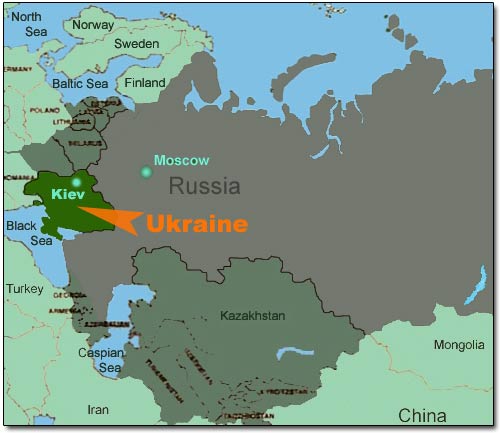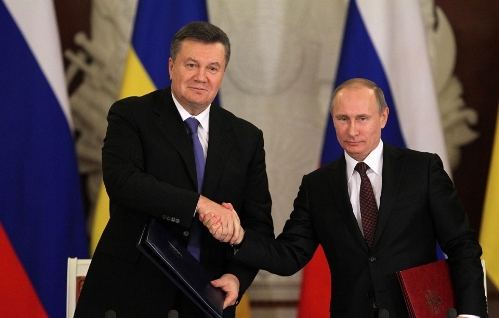| Editor's Introduction: Since their genesis on November 21 last year, the eyes of many have been fixed on the protests in Ukraine, attempting to understand and explain the violence perpetrated against the government. The protestors have called for the resignation of Viktor Yanukovych, democratically elected as President of Ukraine in 2010, and his government. The protestors' demand that President Yanukovych agree to lead the country into membership with the European Union is puzzling for many in light of the failure of EU economic policies over the last 6 years. Their protests beg the question, "What's in it for Ukraine?" The protestors claims of "widespread government corruption, abuse of power and violations of human rights" sound very much like the accusations leveled against other governments that have not followed in lock-step with US/European demands. When viewed in light of the corruption, abuse and human rights violations in the West, the hypocrisy is transparent. The timing of these protests may also offer insight for understanding the US, EU and Russian geopolitical interests, shedding light on the current rioting, mainly in Kiev and Western Ukraine (see language map below). 4 years ago (Jan 1, 2010) The Customs Union of Belarus, Kazakhstan, and Russia was created as the first step toward forming an economic alliance of former Soviet states, similar to that of the European Union. The plan continued economic integration by removing all customs borders between the 3 states by July 2011. On November 19, 2011 they established a joint commission to work out closer economic ties with a plan to create a Eurasian Union by 2015. The United States and EU have openly opposed this unification for obvious reasons. Moreover, the protest demands that President Yanukovych step down has a clear ring of "regime change" instigated by foreign interference in domestic affairs of other nations such as Iraq, Libya and Syria. The protests also fit with the ongoing attempts by the US and NATO to encircle Russia militarily and disrupt its economic viability. Dallas Darling who specializes in analysing world affairs from a historical perspective explains ways in which the Ukraine and Russia have been integrated by means of geography, language, customs and culture for centuries and why wresting Ukraine from the orbit of Russian influence is unlikely. - Les Blough, Editor Axis of Logic
As hard as the European Union, United States, and NATO’s military complex tries to wrestle the Ukraine away from Russian influence, they will probably never succeed. Like the Dnieper River that runs deep through the Ukraine, originating just west of Moscow, Ukrainian and Russian physical, economical, political, cultural, historical, and psychological geographies run deep too. Although the Ukraine is a part of Eurasia, it is buffeted from Europe by the Carpathian Mountains. Its core capital cities also lie on the coast, looking away from Europe and inwards, towards the direction of Russia. Therefore, it is more Russian than European, the pincer of Eurasia which Russia will never forgo without a struggle. And as the Dnieper River connects Russia with the Ukraine, so does Russia’s shared coastline with the Sea of Azov and Black Sea. The Crimean, given to Ukraine by Stalinists, also serves to blend the two nations together, with some Russians even agitating for its return. Shared Russian and Ukrainian physical geographies will be difficult to pry apart. Nor will unification with the European Union and within the U.S.’s and NATO’s spheres of influence solve Ukraine’s geographical determinism. Along with being heavily dependent on imported oil from Russia-Ukraine is the fourth-largest importer and sixth-largest consumer of natural gas in the world-it has suffered from environmental degradation. In a paradoxical way, some Russians maintain a sense of responsibility for the Chernobyl Nuclear Power Plant disaster and coal mining pollution that benefited Stalinist industrialization. This imperial benevolence also consists in investments and trade. Just as Ukrainians depend on Russia’s oil, Russians depend on Ukrainian coal and iron ore.
Ukraine’s geopolitical and religious culture is just as complex as its physical and economical ties with Russia. Whereas western Ukraine, known for its traditional nationalism, is predominately Uniate Catholic, eastern and southern Ukraine is mainly Eastern Orthodox. It is in this region, too, that the majority of Ukranians live, largely consisting of Russians. Because of this, Stalin favored them, even ceding the Crimea to Ukraine in 1954. And in 2004 when Ukraine experienced a so-called Orange Revolution, Viktor Yushcenko’s volte-face democratic and economic reforms instead brought about market corruption and severe price increases. Some Ukrainians long to be reunited with Russia again, perceiving it to be a golden age. Although Ukraine suffered tremendous losses during Stalin’s collectivization, the Soviets ensured that Ukrainians were subjected to policies of political, cultural, linguistic, and historical Russification. Due to Soviet attempts to recruit Russified Ukrainians into elite positions and imperial control, they referred to them as “younger brothers.”1 Also, Glasnost came late to the Ukraine, forestalling its semi-independence from the Commonwealth of Independent and then Russian Federation. Russiafication runs just as deep in the Ukraine as the river Dnieper, which originates just west of Moscow. Kievan Rus, located in present-day Ukraine, was the center of East Slavic and Viking civilization-actually both cofounders of Russia-from the ninth through the twelfth centuries. Although the Mongol invasions gave rise to three separate identities: Russians, Ukrainians, and Belorussians, and having endured the Polish-Lithuanian Commonwealth in the seventeenth century, except for western Ukraine most of Ukraine fell to Russian control. During World War Two, Stalin incorporated western Ukraine into the Soviet Union from Poland, making Ukrainians unite within a single political entity. Many Ukrainians do not even know their native language nor traditions.
For the West, and thanks to idealistic geopolitical thinking and modernization, maps are a kind of virtual reality. But in the East, they serve as cartographic devices that attempts to not only understand physical, political, and cultural realities, but also influence perceptual realities. Russian maps still include a Eurasia Russia, which ensures that Moscow will not be viewed as an outsider. Russia even makes Eastern European states appear more central, with the Ukraine closer to Russia than that of Europe.2 Seldom do distant nations which are guided by imperial illusions redraw political maps, let alone the real personal cartographic expressions on the ground. Like the Russians who are agitating for the return of the Crimean Peninsula, the United States, NATO, and the European Union are also agitators, hoping to wrestle control of the Ukraine from Russia. Such futile dreams may even cause more human misery, ending in utter geographic disasters, like Iraq, Afghanistan, Syria, Egypt, etc… Legacies of dependency and usefulness, like the recent agreement between Russia and the Ukraine to extend the lease of its Black Sea Fleet base in return for lower gas prices(3), are usually difficult to shake-off. Neither can geography’s rightful place in geopolitics be easily overcome. Russification will prevail with the Ukraine being its western anchor. (photographs and related comments added by Axis of Logic) Dallas Darling (Dallas Darling is the author of Politics 501: An A-Z Reading on Conscientious Political Thought and Action, Some Nations Above God: 52 Weekly Reflections On Modern-Day Imperialism, Militarism, And Consumerism in the Context of John‘s Apocalyptic Vision, and The Other Side Of Christianity: Reflections on Faith, Politics, Spirituality, History, and Peace. He is a correspondent for www.worldnews.com. You can read more of Dallas’ writings at www.beverlydarling.com and wn.com//dallasdarling.) (1) Krieger, Joel. The Oxford Companion To Politics Of The World. New York, New York: Oxford University Press: 2003., p. 163. (2) Kaplan, Robert D. The Revenge Of Geography. New York, New York: Random House, 2012., p. 366. (3) Ibid., p. 181. |

